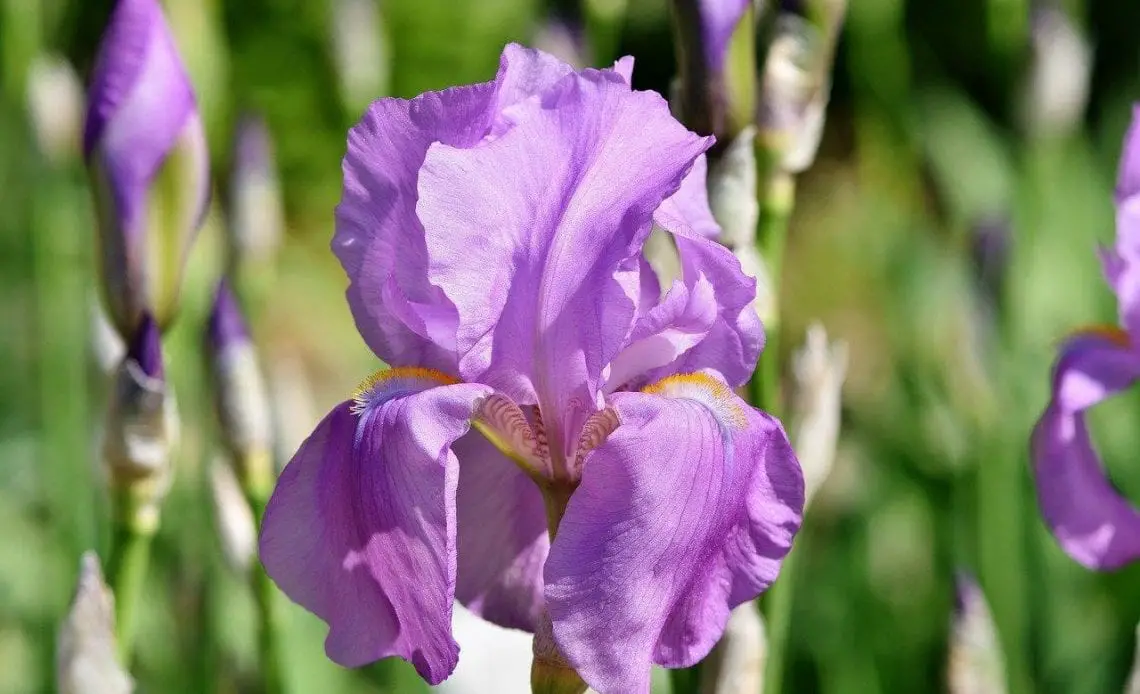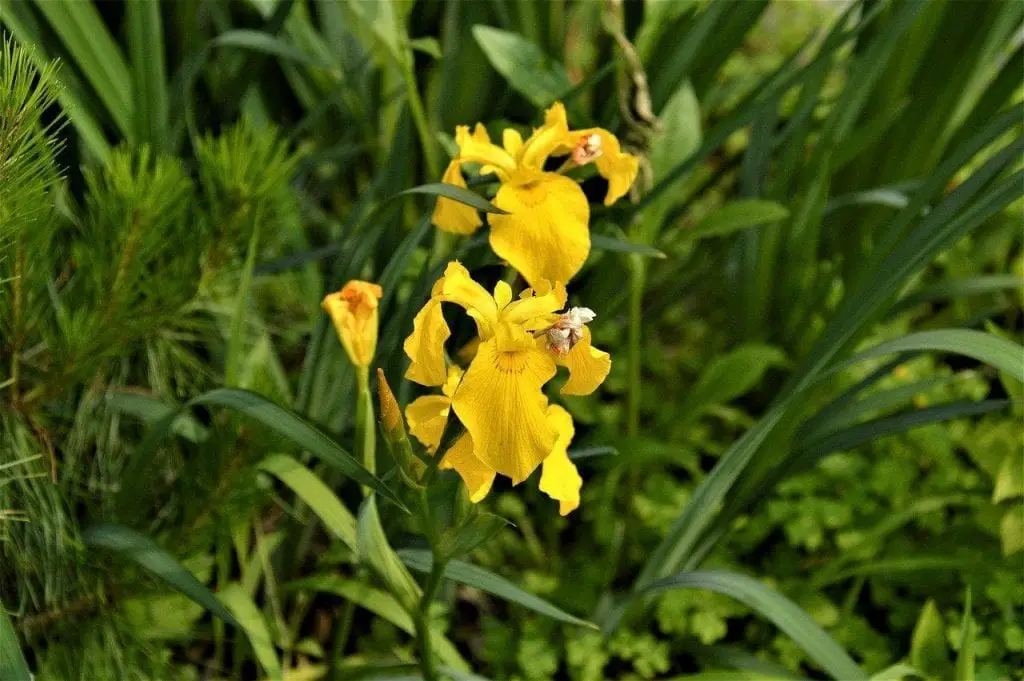
Iris is a perennial flowering plant named after a Greek Goddess. Botanically, the Iris plant is of ‘Iris’ Genus under the ‘Iridaceae’ Family. There are around 300 species of iris. Some species bloom as early as February. It has a variety of colors and grows mostly in Europe and North America. The plant generally grows in early summer when the temperature is around 4 degrees to 10 degrees Celcius. It requires well-drained soil for cultivation. Iris needs a good amount of sunlight to bloom. They mainly grow in cold mountain areas or dry semi-deserts.
The two main types of Iris are Rhizomatous (growing from Rhizomes) and Bulbous (growing from bulbs).
Based on rhizomes, it can be further classified as Bearded Rhizome Iris, Beardless Rhizome Iris, and Crested Rhizome Iris. Similarly, based on bulbs, it can be classified as Bulbing Juno Iris, Bulbing European Iris, and Bulbing Reticulate Iris.
Interestingly, the cultivator names the flowers. Sometimes the flower is named after them itself. For example, Katherine and George are two varieties of Bulbing European Iris (discussed below), and these flowers are named after their cultivator. Similarly, Harmony is a variety of Bulbing Reticulated Iris (discussed below) named after its cultivator Harmony.
These types of Iris grow in summer. They grow from rhizomes (a kind of stem). Following are Rhizomatous types of Iris
a) Bearded Iris:
These are the most famous types of Iris. They are considered popular perennial plants. Bearded Irises grow mostly in Canada and North America in gardens. The characteristic ‘beard’ of these types of Iris is the colored or white hair in the center of petals. They are ideally planted between July and September and need at least 6-8 hours of sunlight. Slope is a good place to plant bearded Irises so that water doesn’t get collected. Tall, Miniature Tall, Standard Dwarf, Miniature Dwarf, Aril, Border, and Intermediate are bearded types of Iris.
Most of these types of flowers are Rebloomers. A few Bearded Irises are used for flavoring in ice-cream, confectionery, and bakery.
Important subtypes of Bearded Iris:-
1. Tall Bearded Iris: They bloom in early May and mid-June and are generally found around the United States. These flowers are around 28 inches (about 70 cm) to 48 inches (about 120 cm) tall. They come in a wide variety of colors. Tall Bearded Irises should be planted in groups of three plants. They need a lot of sunlight, so they should be exposed well to the sun for healthy blooming. Tall bearded Irises should be divided every four to five years. Nitrogen fertilizer should not be used for these Irises. They should not be over-watered.
Abdoza, Badlands, Baja Blue, Blind Ambition are a few names of Tall Bearded Iris
2. Dwarf Bearded Iris: They are also known as Patio Iris. These flowers have a height of 5 inches (about 13 cm) to 15 inches (about 38 cm) and are ideal miniature plants. Dwarf Bearded Iris is generally planted in balconies but is a good plant for rock gardens too. These flowers bloom in early spring.
April Fanfare, Birthmark, Barnie, and Ballistic are a few examples of Dwarf Bearded Iris.
b) Beardless Iris:
These types of Iris have smooth outer petals, unlike the bearded Iris. They occur worldwide and are considered low maintenance flowers. They require full sunlight. The five Beardless types of Iris are Japanese, Siberian, Louisiana, Pacific Coast, and Spuria. They look beautiful, even when not blooming. In these flowers, bees get attracted to the bright color of the outer petals, called signals.
It is interesting to note that a few varieties of Siberian types of Iris are also called Rebloomers because they repeat the bloom later in the season.
Spuria Iris is the tallest type of Beardless Iris. They grow as long as 5 inches. Spuria Iris grow in the temperate climate of Siberia.
Important subtypes of Beardless Iris:-
1. Siberian Iris: They are also called Siberian Flag Iris. Siberian Iris grows in temperate climate around Europe and parts of Central Aisa. Though they are named Siberian Iris, they do not grow in Siberia. They are suitable plants for wild gardens and to grow near ponds. Siberian Iris requires full sunlight and grow in well-drained acidic soil. Ideally, they should be planted in early spring.
Pansy Purple, Mad Magenta, Jewelled Crown, and Blueberry Fair are a few examples of Siberian Iris.
2. Louisiana Iris: They are natives of Louisiana, Florida, and Arkansas in the US. They come in various colors and grow in a warm or temperate climate. Ponds and aquatic gardens are an ideal place for their plantation. Louisiana Iris grows about 60-90 cm in height. They require at least six to eight hours of sunlight. These plants need enough water. Louisiana Iris should be divided in early summer.
Sinfonietta, Black Gamecock, Frank Chowning, and Ginny’s Choice are a few examples of Lousiana Iris.
c) Crested Iris:
It is also called dwarf crested Iris. Its flowers are blue, lavender, or white. Crested Iris flowers don’t have ‘beard’ and ‘signals’. The name ‘Crested’ is derived from the yellow or orange crest in these flowers. The flower is found in North American temperate regions. Crested Iris is an ornamental plant that also grows in forests, near streams, or on mountain edges. It blooms between March and May. They grow in the shade and need moist soil.
It should be noted that Crested Iris has no sub-types. Crested Iris is a flower in itself.

d) Bulbous Iris:
These types of Iris grow from bulbs. They shed their leaves after blooming and become dormant in summer. These types of Iris have short shaped leaves and erect stalks having bright colored flowers. Some Bulbous types of Iris bloom early, while others are late bloomers.
The three main types of Bulbous Iris are: Bulbing Juno, Bulbing European, and Bulbing Reticulate Iris.
1. Bulbing Juno: It is commonly called Junos and is the most common type of Bulbous Iris. It is dormant in summer and grows in mid-winter or early spring. Bulbing Junos are scented flowers. Junos is found in Central Asian countries like Turkey, Iraq, Syria, and also in Afghanistan, where it grows on stony and grassy slopes. Some varieties of Junos also grow in Tajikistan and Uzbekistan. They come in White, Blue, Yellow, and Lavender colors depending on the variety.
Olof, Princess, Dushanbe, and Snow White are a few examples of Bulbing Juno Iris.
2. Bulbing European: These types of Iris are found in Europe. Dutch Iris, Spanish Iris, and English Iris are all Bulbing European Iris. The English and Spanish Iris are very common with florists and in European gardens. Interestingly, both are of Spanish origin. They grow in well-drained soil in a shelter and come in varied colors.
A variety of Bulbing European Iris, known as the Netted Iris, is found in Russia and Northern Iran. It comes in pale blue, deep blue, or purple color and is scented. The flower has a netted surface that gives these flowers the name.
Pixie, Bronze Queen, Golden Harvest, and Purple Sensation are a few names of Bulbing European Iris.
3. Bulbing Reticulate Iris: These scented flowers are the earliest bloomers in spring. They grow only 5-inch tall. Moist and well-drained soil is required for these flowers. They can grow both in the sun and also in part shade. The Reticulated Iris comes in Purplish-Blue, Yellow and White colors. However, the purple color in these flowers is dominant. These flowers bloom for just two weeks.
Harmony, Dan Ford, and Black Iris are the names of Bulbing Reticulate Iris
Interestingly, Dan Ford Iris blooms for even a shorter period than the other Bulbing Reticulate Iris.
Use of Iris plant in medicine and food
The discussion on Iris cannot be complete without mentioning its medicinal values and use for cosmetics and perfumes. Iris plants are grown since time immemorial for their pleasing colors, aromatic and therapeutic properties.
Almost all the parts of the Iris plant are used for various purposes.
Its dry rhizomes are given to children during their teething stage by pediatricians.
The essential oil extracted from the flowers is used for aromatherapy as sedative medicine.
Certain good gin producers use iris roots and flowers to give a specific flavor and color to the final product.
Conclusion
Flowers are one of the most beautiful creations of God. Iris is one of them. We see that there are so many types of Iris in different varieties and beautiful colors. All types of Iris don’t grow the same way. They either grow from rhizomes or bulbs. These flowers grow mostly in Europe and North America, but a few also grow in Asian countries. Iris flowers with flattened leaves are the most common Iris found in gardens.
One can definitely choose an Iris from the above to adorn the garden.
